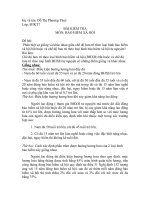Tài liệu Bài 7: What is Independent Component Analysis? docx
Bạn đang xem bản rút gọn của tài liệu. Xem và tải ngay bản đầy đủ của tài liệu tại đây (540.46 KB, 19 trang )
Part II
BASIC INDEPENDENT
COMPONENT ANALYSIS
Independent Component Analysis. Aapo Hyv
¨
arinen, Juha Karhunen, Erkki Oja
Copyright
2001 John Wiley & Sons, Inc.
ISBNs: 0-471-40540-X (Hardback); 0-471-22131-7 (Electronic)
7
What is Independent
Component Analysis?
In this chapter, the basic concepts of independent component analysis (ICA) are
defined. We start by discussing a couple of practical applications. These serve as
motivation for the mathematical formulation of ICA, which is given in the form of a
statistical estimation problem. Then we consider under what conditions this model
can be estimated, and what exactly can be estimated.
After these basic definitions, we go on to discuss the connection between ICA
and well-known methods that are somewhat similar, namely principal component
analysis (PCA), decorrelation, whitening, and sphering. We show that these methods
do something that is weaker than ICA: they estimate essentially one half of the model.
We show that because of this, ICA is not possible for gaussian variables, since little
can be done in addition to decorrelation for gaussian variables. On the positive side,
we show that whitening is a useful thing to do before performing ICA, because it
does solve one-half of the problem and it is very easy to do.
In this chapter we do not yet consider how the ICA model can actually be estimated.
This is the subject of the next chapters, and in fact the rest of Part II.
7.1 MOTIVATION
Imagine that you are in a room where three people are speaking simultaneously. (The
number three is completely arbitrary, it could be anything larger than one.) You also
have three microphones, which you hold in different locations. The microphones give
you three recorded time signals, which we could denote by
x
1
(t)x
2
(t)
and
x
3
(t)
,
with
x
1
x
2
and
x
3
the amplitudes, and
t
the time index. Each of these recorded
147
Independent Component Analysis. Aapo Hyv
¨
arinen, Juha Karhunen, Erkki Oja
Copyright
2001 John Wiley & Sons, Inc.
ISBNs: 0-471-40540-X (Hardback); 0-471-22131-7 (Electronic)
148
WHAT IS INDEPENDENT COMPONENT ANALYSIS?
0 500 1000 1500 2000 2500 3000
0.5
0
0.5
0 500 1000 1500 2000 2500 3000
−1
0
1
0 500 1000 1500 2000 2500 3000
−1
0
1
Fig. 7.1
The original audio signals.
signals is a weighted sum of the speech signals emitted by the three speakers, which
we denote by
s
1
(t)s
2
(t)
,and
s
3
(t)
. We could express this as a linear equation:
x
1
(t)=a
11
s
1
(t)+a
12
s
2
(t)+a
13
s
3
(t)
(7.1)
x
2
(t)=a
21
s
1
(t)+a
22
s
2
(t)+a
23
s
3
(t)
(7.2)
x
3
(t)=a
31
s
1
(t)+a
32
s
2
(t)+a
33
s
3
(t)
(7.3)
where the
a
ij
with
i j =1 ::: 3
are some parameters that depend on the distances
of the microphones from the speakers. It would be very useful if you could now
estimate the original speech signals
s
1
(t)s
2
(t)
,and
s
3
(t)
, using only the recorded
signals
x
i
(t)
. This is called the cocktail-party problem. For the time being, we omit
any time delays or other extra factors from our simplified mixing model. A more
detailed discussion of the cocktail-party problem can be found later in Section 24.2.
As an illustration, consider the waveforms in Fig. 7.1 and Fig. 7.2. The original
speech signals could look something like those in Fig. 7.1, and the mixed signals
could look like those in Fig. 7.2. The problem is to recover the “source” signals in
Fig. 7.1 using only the data in Fig. 7.2.
Actually, if we knew the mixing parameters
a
ij
, we could solve the linear equation
in (7.1) simply by inverting the linear system. The point is, however, that here we
know neither the
a
ij
nor the
s
i
(t)
, so the problem is considerably more difficult.
One approach to solving this problem would be to use some information on
the statistical properties of the signals
s
i
(t)
to estimate both the
a
ij
and the
s
i
(t)
.
Actually, and perhaps surprisingly, it turns out that it is enough to assume that
MOTIVATION
149
0 500 1000 1500 2000 2500 3000
−1
0
1
0 500 1000 1500 2000 2500 3000
−2
0
2
0 500 1000 1500 2000 2500 3000
−1
0
1
2
Fig. 7.2
The observed mixtures of the original signals in Fig. 7.1.
0 500 1000 1500 2000 2500 3000
−5
0
5
10
0 500 1000 1500 2000 2500 3000
−5
0
5
0 500 1000 1500 2000 2500 3000
−5
0
5
Fig. 7.3
The estimates of the original signals, obtained using only the observed signals in
Fig. 7.2. The original signals were very accurately estimated, up to multiplicative signs.
150
WHAT IS INDEPENDENT COMPONENT ANALYSIS?
s
1
(t)s
2
(t)
,and
s
3
(t)
are, at each time instant
t
, statistically independent.This
is not an unrealistic assumption in many cases, and it need not be exactly true in
practice. Independent component analysis can be used to estimate the
a
ij
based on
the information of their independence, and this allows us to separate the three original
signals,
s
1
(t)
,
s
2
(t)
,and
s
3
(t)
, from their mixtures,
x
1
(t)
,
x
2
(t)
,and
x
2
(t)
.
Figure 7.3 gives the three signals estimated by the ICA methods discussed in the
next chapters. As can be seen, these are very close to the original source signals
(the signs of some of the signals are reversed, but this has no significance.) These
signals were estimated using only the mixtures in Fig. 7.2, together with the very
weak assumption of the independence of the source signals.
Independent component analysis was originally developed to deal with problems
that are closely related to the cocktail-party problem. Since the recent increase of
interest in ICA, it has become clear that this principle has a lot of other interesting
applications as well, several of which are reviewed in Part IV of this book.
Consider, for example, electrical recordings of brain activity as given by an
electroencephalogram (EEG). The EEG data consists of recordings of electrical
potentials in many different locations on the scalp. These potentials are presumably
generated by mixing some underlying components of brain and muscle activity.
This situation is quite similar to the cocktail-party problem: we would like to find
the original components of brain activity, but we can only observe mixtures of the
components. ICA can reveal interesting information on brain activity by giving
access to its independent components. Such applications will be treated in detail in
Chapter 22. Furthermore, finding underlying independent causes is a central concern
in the social sciences, for example, econometrics. ICA can be used as an econometric
tool as well; see Section 24.1.
Another, very different application of ICA is feature extraction. A fundamental
problem in signal processing is to find suitable representations for image, audio or
other kind of data for tasks like compression and denoising. Data representations
are often based on (discrete) linear transformations. Standard linear transformations
widely used in image processing are, for example, the Fourier, Haar, and cosine
transforms. Each of them has its own favorable properties.
It would be most useful to estimate the linear transformation from the data itself,
in which case the transform could be ideally adapted to the kind of data that is
being processed. Figure 7.4 shows the basis functions obtained by ICA from patches
of natural images. Each image window in the set of training images would be
a superposition of these windows so that the coefficient in the superposition are
independent, at least approximately. Feature extraction by ICA will be explained in
more detail in Chapter 21.
All of the applications just described can actually be formulated in a unified
mathematical framework, that of ICA. This framework will be defined in the next
section.
DEFINITION OF INDEPENDENT COMPONENT ANALYSIS
151
Fig. 7.4
Basis functions in ICA of natural images. These basis functions can be considered
as the independent features of images. Every image window is a linear sum of these windows.
7.2 DEFINITION OF INDEPENDENT COMPONENT ANALYSIS
7.2.1 ICA as estimation of a generative model
To rigorously define ICA, we can use a statistical “latent variables” model. We
observe
n
random variables
x
1
:::x
n
, which are modeled as linear combinations of
n
random variables
s
1
:::s
n
:
x
i
= a
i1
s
1
+ a
i2
s
2
+ ::: + a
in
s
n
for all
i =1:::n
(7.4)
where the
a
ij
ij = 1 ::: n
are some real coefficients. By definition, the
s
i
are
statistically mutually independent.
This is the basic ICA model. The ICA model is a generative model, which means
that it describes how the observed data are generated by a process of mixing the
components
s
j
. The independent components
s
j
(often abbreviated as ICs) are latent
variables, meaning that they cannot be directly observed. Also the mixing coefficients
a
ij
are assumed to be unknown. All we observe are the random variables
x
i
,andwe
must estimate both the mixing coefficients
a
ij
and the ICs
s
i
using the
x
i
. This must
be done under as general assumptions as possible.
Note that we have here dropped the time index
t
that was used in the previous
section. This is because in this basic ICA model, we assume that each mixture
x
i
as
well as each independent component
s
j
is a random variable, instead of a proper time
signal or time series. The observed values
x
i
(t)
, e.g., the microphone signals in the
152
WHAT IS INDEPENDENT COMPONENT ANALYSIS?
cocktail party problem, are then a sample of this random variable. We also neglect
any time delays that may occur in the mixing, which is why this basic model is often
called the instantaneous mixing model.
ICA is very closely related to the method called blind source separation (BSS) or
blind signal separation. A “source” means here an original signal, i.e., independent
component, like the speaker in the cocktail-party problem. “Blind” means that we
know very little, if anything, of the mixing matrix, and make very weak assumptions
on the source signals. ICA is one method, perhaps the most widely used, for
performing blind source separation.
It is usually more convenient to use vector-matrix notation instead of the sums
as in the previous equation. Let us denote by
x
the random vector whose elements
are the mixtures
x
1
:::x
n
, and likewise by
s
the random vector with elements
s
1
:::s
n
. Let us denote by
A
the matrix with elements
a
ij
. (Generally, bold
lowercase letters indicate vectors and bold uppercase letters denote matrices.) All
vectors are understood as column vectors; thus
x
T
, or the transpose of
x
,isarow
vector. Using this vector-matrix notation, the mixing model is written as
x = As
(7.5)
Sometimes we need the columns of matrix
A
; if we denote them by
a
j
the model
can also be written as
x =
n
X
i=1
a
i
s
i
(7.6)
The definition given here is the most basic one, and in Part II of this book,
we will essentially concentrate on this basic definition. Some generalizations and
modifications of the definition will be given later (especially in Part III), however.
For example, in many applications, it would be more realistic to assume that there
is some noise in the measurements, which would mean adding a noise term in the
model (see Chapter 15). For simplicity, we omit any noise terms in the basic model,
since the estimation of the noise-free model is difficult enough in itself, and seems to
be sufficient for many applications. Likewise, in many cases the number of ICs and
observed mixtures may not be equal, which is treated in Section 13.2 and Chapter 16,
and the mixing might be nonlinear, which is considered in Chapter 17. Furthermore,
let us note that an alternative definition of ICA that does not use a generative model
will be given in Chapter 10.
7.2.2 Restrictions in ICA
To make sure that the basic ICA model just given can be estimated, we have to make
certain assumptions and restrictions.
1. The independent components are assumed statistically independent.
This is the principle on which ICA rests. Surprisingly, not much more than this
assumption is needed to ascertain that the model can be estimated. This is why ICA
is such a powerful method with applications in many different areas.









